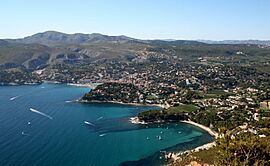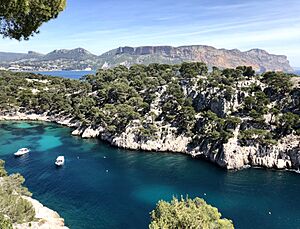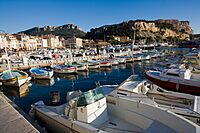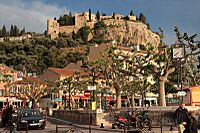Cassis facts for kids
Quick facts for kids
Cassis
Cassís (Occitan)
|
||
|---|---|---|

Cassis seen from the cliffs of Cap Canaille
|
||
|
||
| Country | France | |
| Region | Provence-Alpes-Côte d'Azur | |
| Department | Bouches-du-Rhône | |
| Arrondissement | Marseille | |
| Canton | La Ciotat | |
| Intercommunality | Aix-Marseille-Provence | |
| Area
1
|
26.86 km2 (10.37 sq mi) | |
| Population
(2021)
|
6,720 | |
| • Density | 250.19/km2 (648.0/sq mi) | |
| Time zone | UTC+01:00 (CET) | |
| • Summer (DST) | UTC+02:00 (CEST) | |
| INSEE/Postal code |
13022 /13260
|
|
| Elevation | 0–416 m (0–1,365 ft) | |
| 1 French Land Register data, which excludes lakes, ponds, glaciers > 1 km2 (0.386 sq mi or 247 acres) and river estuaries. | ||
Cassis (pronounced kah-SEE) is a charming town in Southern France. It's located east of Marseille in the Bouches-du-Rhône area, which is part of the Provence-Alpes-Côte d'Azur region. This coastline is often called the French Riviera.
Cassis is a very popular place for tourists. It's famous for its tall cliffs, known as falaises (fah-LEZ), and its beautiful, sheltered coves called calanques (kah-LANK). The town is also known for its delicious white and rosé wines. Don't mix these up with crème de cassis, which is a blackcurrant drink from a different part of France! Cassis was even a filming spot for the movie The French Connection.
Contents
Exploring Cassis's Location
Cassis sits right on the Mediterranean Sea coast. It's about 20 kilometers (12 miles) east of the big city of Marseille. One of the most amazing natural features nearby is Cap Canaille. This huge cliff is 394 meters (1,293 feet) tall and is one of the highest sea cliffs in Europe. Sailors have used it as a landmark for thousands of years!
Cassis has a main beach called "Bestouan." It stays cool thanks to a special underground water source that flows into it.
A Look Back at Cassis's History
Cassis has a long and interesting history. The first people to live here were called the Ligures. They settled between 600 and 500 BC. They built a strong, fortified home on top of a hill called Baou Redon. These early settlers were hunters, fishers, and farmers.
Later, during the time of Ancient Rome, Cassis was a small village. It was mainly built around the beaches of Arena and Corton. People here made their living by fishing and trading by sea. They traded with places like North Africa and the Middle East. We know this from old objects found by archaeologists.
From the 5th to the 10th centuries AD, different tribes invaded the area. Because of this, people moved to a fortified city called a castrum for safety. This castrum later became the property of a powerful family in 1223.
In the 15th century, Cassis became part of the lands ruled by the Counts of Provence. After that, a ruler named René of Anjou gave the town to the Bishops of Marseille. They governed Cassis until the French Revolution in 1789.
Cassis's Growing Industries
In the 18th century, Cassis started to grow outside its old fortified walls. New businesses began to appear, especially around the port. After the Bourbon Restoration in France, even more industries developed.
These included:
- Drying cod fish
- Making olive oil
- Producing clothing
- Working with coral
- Making wine
- Quarrying local stone
The "Stone of Cassis" became very famous. It had been used since ancient times. This stone was used to build the docks of many large Mediterranean ports. These included Alexandria, Algiers, Piraeus, Marseille, and Port Said. There was a story that it was used for the base of the Statue of Liberty in New York City, but this has been proven not true. Today, the stone is mostly used for things like sinks and fireplaces in homes.
As the 20th century began, many of these older industries started to fade away. People in Cassis then focused more on tourism and making wine. Cassis was one of the first three vineyards in France to get a special label in 1936. This label, called appellation d'origine contrôlée, guarantees the quality and origin of the wine.
What's in a Name?
The name "Cassis" has a long history. The oldest known form, from the first century, was "Tutelæ Charsitanæ." Over time, it changed to "Carsicis" and then "Castrum Cassitis." These names suggest that "Car-" might come from an old word meaning "stone" or "rock."
In the local language, Provençal, the "s" at the end of Cassis is usually not pronounced. However, in the town's famous motto, it is pronounced.
The Provençal motto for Cassis is "Qu'a vist Paris, se noun a vist Cassis, n'a rèn vist." This means, "Who has seen Paris and not Cassis, has seen nothing!" It's a fun way to say how special Cassis is.
Cassis's Sister Cities
Cassis is connected to other towns around the world through "twinning" or "sister city" programs. These connections help people from different places learn about each other's cultures.
Cassis is twinned with:
 Burnham-on-Sea, United Kingdom
Burnham-on-Sea, United Kingdom Portofino, Italy
Portofino, Italy Alushta, Ukraine
Alushta, Ukraine
Famous People from Cassis
Many interesting people have connections to Cassis:
- Jean-Jacques Barthélemy (1716–1795): A writer and expert in old coins, born in Cassis.
- Henri Crémieux: A stage and film actor who passed away in his home in Cassis. A street there is named after him.
- Jerome Hill (1905-1972): An American filmmaker and generous supporter of good causes.
- René Leriche (1879-1955): A very important surgeon who died in Cassis. A street is named in his honor.
- Rudy Ricciotti (born 1952): A famous architect who lived in Cassis. He designed big buildings like the Musée des Civilisations de l'Europe et de la Méditerranée.
- Jean-Pierre Teisseire (born 1940): A politician and professor who was the mayor of Cassis from 1995 to 2008.
- Michel Platini (born 1955): A legendary football (soccer) player and manager.
- Adil Rami (born 1985): A professional football player who played as a central defender for a French club.
Population Over Time
| Historical population | |||||||||||||||||||||||||||||||||||||||||||||||||||||||||||||||||||||||||||||||||||||||||||||||||||||||||||||||||||
|---|---|---|---|---|---|---|---|---|---|---|---|---|---|---|---|---|---|---|---|---|---|---|---|---|---|---|---|---|---|---|---|---|---|---|---|---|---|---|---|---|---|---|---|---|---|---|---|---|---|---|---|---|---|---|---|---|---|---|---|---|---|---|---|---|---|---|---|---|---|---|---|---|---|---|---|---|---|---|---|---|---|---|---|---|---|---|---|---|---|---|---|---|---|---|---|---|---|---|---|---|---|---|---|---|---|---|---|---|---|---|---|---|---|---|---|
|
|
||||||||||||||||||||||||||||||||||||||||||||||||||||||||||||||||||||||||||||||||||||||||||||||||||||||||||||||||||
| Source: EHESS and INSEE (1968-2017) | |||||||||||||||||||||||||||||||||||||||||||||||||||||||||||||||||||||||||||||||||||||||||||||||||||||||||||||||||||
Images for kids
-
Francis Picabia and friends at an outdoor café in Cassis
See also
 In Spanish: Cassis para niños
In Spanish: Cassis para niños









